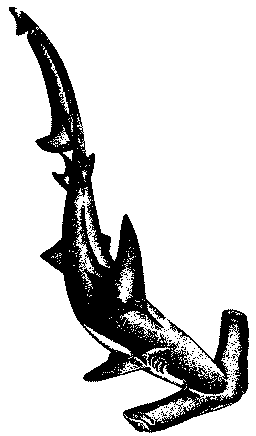 |
Science Frontiers ONLINE No. 65: Sep-Oct 1989 |
|
|
Why the hammer head?

|
- The head acts as a hydrofoil and gives the heavier-than-water, swimbladderless shark better swimming control.
- Grooves on the hammer head channel water toward the nostrils, providing "stereoscopic sniffing."
- The head is a platform for electromagnetic sensors that help locate prey. Stingrays are a favorite food of the hammerhead, and the shark may de-tect them electromagnetically, as surmised by the author of this article in the following encounters:
"I have observed great hammerheads swimming close to the bottom, swinging their heads in wide arcs (a motion common, in a lesser degree, to all large sharks) as if using the increased electroreceptive area of their hammer like the sensor plate of a metal detector. Sometimes, these animals would doubleback to scoop up one of several stingrays hiding in the bottom silt. The minute electrical pulse that keeps the stingray's heart and spiracles operating betrays their presence to a hungry hammerhead."
(Martin, Richard; "Why the Hammer Head?" Sea Frontiers, 35:142, 1989.)